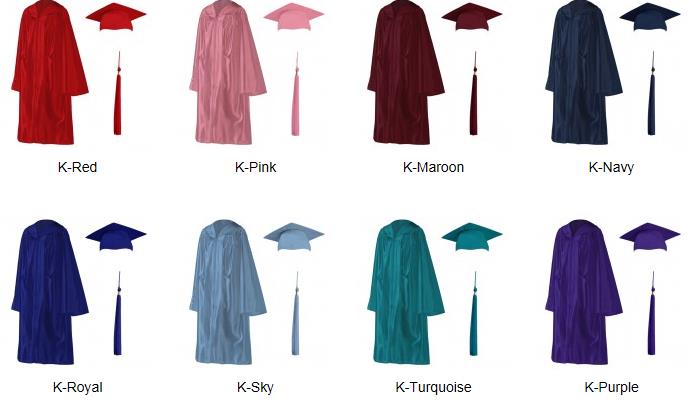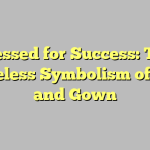
As we embark on the journey of academic achievement, there is a pivotal moment that symbolizes the culmination of years of hard work and dedication: the donning of caps and gowns. This time-honored tradition transcends educational levels, from preschoolers to masters degree graduates, and holds a profound significance in celebrating academic accomplishments and marking a new chapter in one’s life.
For the youngest scholars, the sight of preschoolers in tiny caps and gowns is undeniably heartwarming. These pint-sized graduates, beaming with pride and excitement, represent the earliest stages of their educational journey. Though they may not fully grasp the significance of their attire, the experience of donning a cap and gown imparts a sense of pride and achievement that will foster their passion for learning from the very beginning.
On the other end of the academic spectrum, we find master’s degree graduates basking in the glory of their hard-won achievements. As they cross the stage, adorned in their caps and gowns, these individuals become the embodiment of perseverance and scholarly excellence. The years of rigorous study, research, and dedication culminate in this significant moment, which marks their entrance into the world of expertise in their chosen fields.
From the tiniest preschooler to the esteemed master’s degree graduate, the cap and gown hold immense symbolic power. They symbolize the transformative power of education, the accomplishments of an individual, and the promise of a bright future. Beyond the fabric and mortarboard lies the stories of countless hours of study, sleepless nights, and the unwavering determination that brought each individual to this moment. So, as we witness the procession of caps and gowns, let us celebrate the incredible power of education and honor the individuals who proudly wear these symbols of success.
The Symbolism of Preschool Cap and Gowns
Preschool cap and gowns hold a special significance in the lives of young children as they embark on their first steps towards education. These miniature versions of the traditional graduation attire serve as a symbol of achievement and mark an important milestone in the lives of these little learners.
Wearing a cap and gown at such a tender age fosters a sense of accomplishment and instills in them the value of effort and perseverance. For preschoolers, donning this attire signifies their progression from early childhood education to the next phase of their academic journey. It symbolizes their growth and readiness to embrace new challenges in the years to come.
Beyond the personal significance, preschool cap and gowns also hold immense value in the eyes of parents and educators. These simple garments act as a tangible representation of their child’s development and serve as a source of pride for families. They encapsulate the hard work and dedication exhibited by both the young learners and their supportive caregivers.
The symbolism of preschool cap and gowns extends beyond the preschool years. It plants the seeds of aspiration and creates a foundation for future academic achievements. As these children reach higher levels of education, they will encounter more elaborate versions of this attire, such as the master degree caps and gowns. The symbolic significance of these garments will continue to evolve, representing the culmination of knowledge and academic excellence.
Through the symbolism of preschool cap and gowns, young children learn the value of education and are encouraged to strive for success. These small yet meaningful garments leave an indelible impression on their impressionable minds, motivating them to pursue their goals and dreams with determination and enthusiasm.
The Importance of Master Degree Caps and Gowns
Master degree caps and gowns hold great significance as they symbolize the culmination of years of hard work and academic achievement. These traditional garments carry a sense of honor and prestige, signifying the successful completion of an advanced level of education.
Puerto Rican graduation stoles
Wearing a master’s degree cap and gown creates a visual representation of one’s educational accomplishment. It showcases the dedication, perseverance, and commitment required to attain this level of expertise in a specific field. The regalia serves as a unifying element among graduates, fostering a sense of camaraderie and shared accomplishment.
Furthermore, the master’s degree cap and gown create a recognizable identity for graduates during commencement ceremonies. The uniformity in attire allows for a sense of equality among students who have put in countless hours of research, study, and hard work to earn their advanced degree. The cap and gown create an atmosphere of solemnity and importance, enhancing the ceremonial experience for both graduates and spectators.
In addition to the symbolism, the master’s degree cap and gown hold practical importance. The cap, traditionally adorned with a tassel, represents the academic field in which the degree is earned. Different colors may signify various areas of study, thus allowing graduates to proudly display their discipline. The gown, typically in a dark shade, represents formality and respect for the occasion. Together, the cap and gown contribute to the overall sense of accomplishment and dignity befitting the master’s degree recipient.
In conclusion, master degree caps and gowns play a vital role in acknowledging the significant achievements of graduates. Beyond their aesthetic appeal, these garments carry profound meaning as symbols of academic success and dedication to higher learning. The tradition and importance attached to the master’s degree cap and gown contribute to the overall celebratory atmosphere of commencement ceremonies, while also honoring the rigorous journey undertaken by each graduate.
Celebrating Academic Achievements
Graduation ceremonies are an integral part of our educational journey. They symbolize the culmination of years of hard work, dedication, and personal growth. For many, these ceremonies mark significant milestones in their academic journey, from preschool to the achievement of a master’s degree. Among the various visual elements that make these graduation ceremonies special, the caps and gowns hold a significant place.
Preschool cap and gown ceremonies signify the beginning of a child’s educational journey. These tiny graduates, clad in miniature caps and gowns, capture the essence of innocence, hope, and the bright future that lies ahead. The ceremony serves as a memorable event for both the children and their families, highlighting the importance of education and instilling confidence and a sense of accomplishment at an early age.
On the other end of the academic spectrum, the master’s degree caps and gowns represent the pinnacle of academic achievement. These individuals have dedicated years to pursue advanced knowledge and expertise in their chosen field. The master’s degree graduation ceremony becomes a moment of pride and celebration for the graduates, as they prepare to embark on new professional endeavors or continue their academic pursuits.
Caps and gowns, worn by graduates of all levels, serve as visual reminders of the academic achievements and the hard work that has led to this moment. They bring a sense of unity and tradition to the graduation ceremony, as every graduate dons the same attire, regardless of their individual accomplishments. This symbolism fosters a collective spirit among the graduates, showcasing their shared commitment to education and perseverance.
In conclusion, the significance of caps and gowns in graduation ceremonies cannot be overstated. From the precious preschoolers embarking on their educational journey to the accomplished individuals receiving their master’s degrees, these ceremonial attire pieces represent the milestones achieved and serve as a visual testament to years of dedication and hard work. They not only unite the graduates but also inspire future generations to strive for academic excellence and celebrate their own accomplishments.


